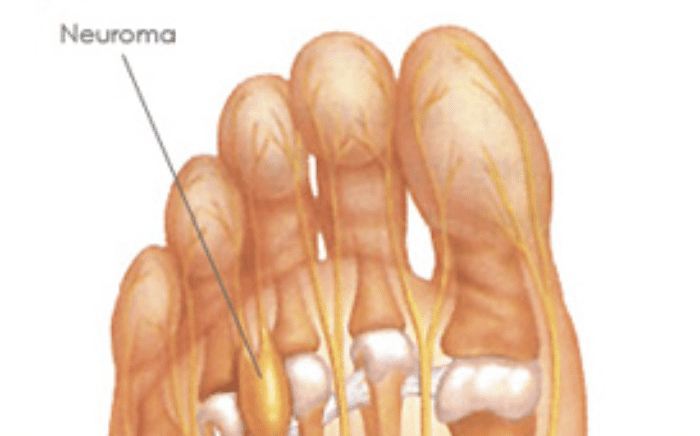What is a Neuroma?
MORTON’s NEUROMA
A neuroma is a painful condition, also referred to as a “pinched nerve” or a nerve tumor. It is a benign growth of nerve tissue frequently found between the third and fourth toes. It brings on pain, a burning sensation, tingling, or numbness between the toes and in the ball of the foot.
The principal symptom associated with a neuroma is pain between the toes while walking. Those suffering from the condition often find relief by stopping their walk, taking off their shoes, and rubbing the affected area. At times, the patient will describe the pain as similar to having a stone in his or her shoe. The vast majority of people who develop neuromas are women.

What Causes Neuroma?
Although the exact cause for this condition is unclear, a number of factors can contribute to the formation of a neuroma:
- Biomechanical deformities, such as a high-arched foot or a flat foot, can lead to the formation of a neuroma. These foot types bring on instability around the toe joints, leading to the development of the condition.
- Trauma can cause damage to the nerve, resulting in inflammation or swelling of the nerve.
- Improper footwear that causes the toes to be squeezed together is problematic. Avoid high-heeled shoes higher than two inches. Shoes at this height can increase pressure on the forefoot area.
- Repeated stress, common to many occupations, can create or aggravate a neuroma.
- A puncture wound or laceration that injures a nerve can cause a neuroma. These are called traumatic Neuromas.
- Neuromas can also result in a surgery that may result in the cutting of a nerve.
Neuroma Diagnosis
The diagnosis of Neuromas is made by a physical exam and a thorough history of the patient’s complaint. Conditions that mimic the pain associated with Neuromas are stress fracture of the metatarsals, inflammation of the tendons in the bottom of the toes, arthritis of the joint between the metatarsal bone and the toe, or nerve compression or nerve damage further up on the foot, ankle, knee, hip, or back. X-rays are generally taken to rule out a possible stress fracture or arthritis. Because nerve tissue is not seen on an x-ray, the x-ray will not show the neuroma.
A skilled foot specialist will be able to actually feel the neuroma on his exam of the foot. Special studies such as MRI, CT Scan, and nerve conduction studies have little value in the diagnosis of a neuroma. Additionally, these studies can be very expensive and generally the results do not alter the doctor’s treatment plan. If the doctor on his exam cannot feel the neuroma, and if the patient’s symptoms are not what is commonly seen, then nerve compression at another level should be suspected. In this instance, one area to be examined is the ankle.
Just below the ankle bone on the inside of the ankle, a large nerve passes into the foot. At this level, the nerve can become inflamed. This condition is called Tarsal Tunnel Syndrome. Generally, there is not pain at this site of the inflamed nerve at the inside of the ankle. Pain may instead be experienced in the bottom of the foot or in the toes. This can be a difficult diagnosis to make in certain circumstances. Neuromas, however, occur more commonly than Tarsal Tunnel Syndrome.
Neuroma in Foot Treatment
Treatment options vary with the severity of each neuroma, and identifying the neuroma early in its development is important to avoid surgical correction.
For simple, undeveloped neuromas, a pair of thick-soled shoes with a wide toe box is often adequate treatment to relieve symptoms, allowing the condition to diminish on its own. For more severe conditions, however, additional treatment or surgery may be necessary to remove the tumor.
The primary goal of most early treatment regimens is to relieve pressure on areas where a neuroma develops. Your podiatric physician will examine and likely X-ray the affected area and suggest a treatment plan that best suits your individual case.
- Padding and Taping: Special padding at the ball of the foot may change the abnormal foot function and relieve the symptoms caused by the neuroma.
- Medication: Anti-inflammatory drugs and cortisone injections can be prescribed to ease acute pain and inflammation caused by the neuroma.
- Orthotics: Custom shoe inserts made by your podiatrist may be useful in controlling foot function. Orthotics may reduce symptoms and prevent the worsening of the condition.
- Surgical Options: When early treatments fail and the neuroma progresses past the threshold for such options, podiatric surgery may become necessary. The procedure, which removes the inflamed and enlarged nerve, can usually be conducted on an outpatient basis, with a recovery time that is often just a few weeks. Your podiatric physician will thoroughly describe the surgical procedures to be used and the results you can expect. Any pain following surgery is easily managed with medications prescribed by your podiatrist.
Our Board Certified Podiatrists
Socal Foot and Ankle doctors are committed to delivering the most exceptional treatments.

Board Certified Foot & Ankle Specialist
Office Time
Location: Santa Monica
Mon – Thur: 9:00 AM – 5:00 PM
Friday: 9:00 AM – 5:00 PM
Location Marina Del Rey
Mon – Thur: 9:00 AM – 5:00 PM
Friday: 9:00 AM – 5:00 PM
Location: Cedars Sinai
Mon – Thur: 9:00 AM – 5:00 PM
Friday: 9:00 AM – 5:00 PM

Board Certified Foot & Ankle Specialist
Office Time
Location: Santa Monica
Mon – Thur: 9:00 AM – 5:00 PM
Friday: 9:00 AM – 5:00 PM

BOARD CERTIFIED
FOOT & ANKLE
Surgeons
- Comprehensive Treatment of Foot & Ankle Conditions in the Pediatric, Adult & Geriatric population
- 3 Practice Locations Santa Monica Medical Plaza, Cedars Sinai Medical Towers, & UCLA Health in Marina Del Rey
- On Staff with Providence Saint Johns Health Center &Cedars Sinai Medical Center
